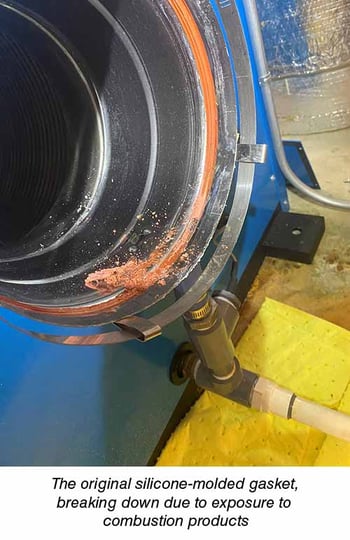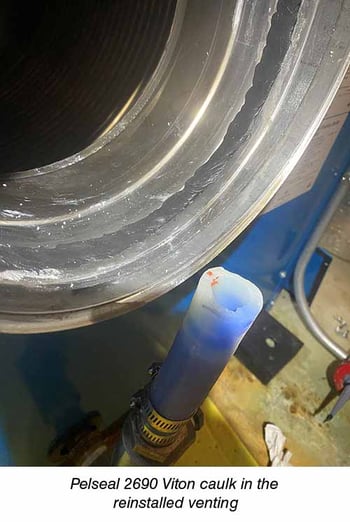Following the installation of a boiler and venting system for an insurance company headquarters, representatives from Butters Fetting Co., a Wisconsin-based safety, building information modeling, and preconstruction project services provider, learned of a gasket failure.
 The problem originated in a venting joint, which was sealed at the time of installation with a high-temperature, silicone-molded gasket. Soon after the installation, the gasket in question had become brittle and was breaking down, compromising the joint and allowing water to leak from the boiler venting onto the floor. The water—which was acidic due to the products of combustion coming from the boiler—was staining the concrete floor below.
The problem originated in a venting joint, which was sealed at the time of installation with a high-temperature, silicone-molded gasket. Soon after the installation, the gasket in question had become brittle and was breaking down, compromising the joint and allowing water to leak from the boiler venting onto the floor. The water—which was acidic due to the products of combustion coming from the boiler—was staining the concrete floor below.
When the gasket failed, Butters Fetting technicians returned to apply RTV, a customary sealant type in venting applications.
Butters Fetting HVAC Systems Specialist, Paul Coburn, says the RTV sealant is actually recommended in most installation manuals to join similar ducts.
The RTV did offer resistance to temperatures up to 600° F, but it, too, was unable to stand up to the corrosive chemicals. Just a few weeks later, the customer called to say that it was leaking again.
“A coworker and I were discussing how to address the issue,” Coburn says. “I was worried we would have to rip out all the venting, but he said we needed a Viton caulk.”
Coburn had heard of Viton but was not familiar with it. “I searched for it and found Pelseal. I saw that the Viton product had an emphasis on solvent- and acid resistance. I said ‘I think this is what we need.’” His only remaining concern was the temperature rating.
Boiler venting can be exposed to temperatures as high as 350~370° F, and during a conversation with Bill Ross, Pelseal’s President, Coburn learned that Viton is able to handle temperatures as high as 450° F.
Ross offered a sample of Pelseal 2690, a Viton caulk, which Coburn used to reseal the venting. When it leaked again after a few weeks, he returned to investigate.
 “The only problem was that we needed more Pelseal,” Coburn says. “The gaps on the venting were very large, and we hadn’t applied enough. We did notice, though, that the bead we had applied looked the same as when it had been installed. There was no wear or degradation whatsoever, even after a few weeks of exposure to the acid.”
“The only problem was that we needed more Pelseal,” Coburn says. “The gaps on the venting were very large, and we hadn’t applied enough. We did notice, though, that the bead we had applied looked the same as when it had been installed. There was no wear or degradation whatsoever, even after a few weeks of exposure to the acid.”
In addition, one advantage of Pelseal is that the original application did not need to be removed. “With RTV we would have had to remove the sealant before reapplying,” Coburn says. “In this case, we just added more 2690 to the existing bead. It was an easy fix.”
At the time of this writing, six months after the reinstallation, Coburn says there have been no leaks or other issues. “That tells me that it’s holding up very well,” he says.
He adds that this is a common problem; Coburn says that most (if not all) of his 200 field technicians face the same issue and typically replace the silicone gaskets as they fail. “This is huge for us,” he says. “The Pelseal Viton caulk represents a significant improvement in our ability to provide durable seals for our customers, even in the harshest environments.”
---
Viton™ and any associated logo is a trademark or copyright of THE CHEMOURS COMPANY FC, LLC used under license by Pelseal® Technologies, LLC.
Pelseal® is a registered trademark of Pelseal Technologies, LLC.
# # #
Latest News
![]() Commercial Boiler Corrosion Solved with Pelseal Viton™ Caulk (read)
Commercial Boiler Corrosion Solved with Pelseal Viton™ Caulk (read)
Flanges leaking acid? You need FLANGE PELSEAL, our liquid Viton caulk. See the independent test results in our new photo brochure. (read)
Pelseal Technologies Featured In SULFURIC ACID TODAY Magazine (read)
Pelseal Technologies New PLV2020 Aerosol Coating Features the Properties of Viton™ Fluoroelastomer in a Convenient, 12 oz. Spray Can (read)
3161 State Road, Ste. G
Bensalem, PA 19020
Phone: 215-245-0581
Fax: 215-245-7606
sales@pelseal.com
Disclaimer: Information and suggestions supplied by Pelseal® Technologies, LLC ("Pelseal"), whether in published literature or otherwise, including samples, are based on technical data that Pelseal believes to be reliable. Such information and suggestions are supplied without charge and their use, and the use of Pelseal's products, are beyond Pelseal's control. Pelseal's products, information and suggestions are intended for use by persons having technical skill and know-how in the industry. Such persons are responsible, at their sole discretion and risk, to satisfy themselves regarding the suitability of Pelseal's products, information and suggestions for their particular use and circumstances. Any handling precaution information is given with the understanding that those using it will satisfy themselves that their particular use conditions present no health or safety hazards. NOT FOR RESIDENTIAL USE.